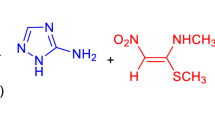Abstract
Aliphatic polyamines, being a versatile class of organic compounds, are widely used in many fields of medicine and organic chemistry. However, the general approach to the synthesis of chiral aliphatic polyamines has been still undeveloped. Here, we describe a new method for the synthesis of chiral trifunctional amino compounds, namely hydroxydiamines and triamines. The initial compounds, namely substituted hydroxy- or aminopyrazolidines and pyrazolines, are readily available using convenient stereoselective methods developed earlier by us. The proposed method allows synthesizing of chiral diaminoalcohols and triamines, which are the analogs of a well-known anti-TB drug, namely ethambutol, and cannot be obtained alternatively. The key step of the synthesis is N–N bond cleavage in substituted hydroxy- or aminopyrazolidines and pyrazolines with borane-tetrahydrofuran complex; other known methods for N–N bond cleavage turned out to be ineffective. The main advantage of the proposed method is the retention of a certain configuration of stereocenters in the course of the reaction. Six new chiral diasteomerically pure substituted hydroxydiamines and triamines and the enantiomerically pure triamine with four chiral centers were synthesized and characterized using NMR, IR and mass spectroscopy, as well as elemental analysis.





Similar content being viewed by others
Abbreviations
- Anti-TB drugs:
-
Antituberculosis drugs
- THF:
-
Tetrahydrofuran
References
Aeberli P, Houlihan WJ (1969) Novel N–CH2–N bridging reaction. J Org Chem 34:2720–2723
Agostinelli E, Tempera G, Molinari A, Salvi M, Battaglia V, Toninello A, Arancia G (2007) The physiological role of biogenic amines redox reactions in mitochondria. New perspectives in cancer therapy. Amino Acids 33:175–187
Bergeron RJ, Muller R, Huang G, McManis JS, Algee SE, Yao H, Weimar WR, Wiegand J (2001) Synthesis and evaluation of hydroxylated polyamine analogues as antiproliferatives. J Med Chem 44:2451–2459
Casero RA Jr, Marton LJ (2007) Targeting polyamine metabolism and function in cancer and other hyperproliferative diseases. Nature 6:373–390
Casero RA Jr, Woster PM (2009) Recent advances in the development of polyamine analogues as antitumor agents. J Med Chem 52:4551–4573
Cooper GJS, Phillips ARJ, Choong SY, Leonard BL, Crossman DJ, Brunton DH, Saafi ’EL, Dissanayake AM, Cowan BR, Young AA, Occleshaw CJ, Chan Y-K, Leahy FE, Keogh GF, Gamble GD, Allen GR, Pope AJ, Boyd PDW, Poppitt SD, Borg TK, Doughty RN, Baker JR (2004) Regeneration of the heart in diabetes by selective copper chelation. Diabetes 53:2501–2508
Cooper GJS, Young AA, Gamble GD, Occleshaw CJ, Dissanayake AM, Cowan BR, Brunton DH, Baker JR, Phillips ARJ, Frampton CM, Poppitt SD, Doughty RN (2009) A copper (II)-selective chelator ameliorates left-ventricular hypertrophy in type 2 diabetic patients: a randomised placebo-controlled study. Diabetologia 52:715–722
Enders D, Lochtman R, Meiers M, Muller S, Lazny R (1998) Efficient N–N bond cleavage of chiral trisubstituted hydrazines with BH .3 THF. Synlett 11:1182–1184
Enders D, Muller S, Raabe G (1999) Enantioselective synthesis of β-amino sulfones by aza-Michael addition to alkenyl sulfones. Angew Chem Int Ed 38(1/2):195–197
Feuer H, Brown F (1970) Chemistry of hydrazides. X. The reduction of cyclic and acyclic hydrazides with diborane. J Org Chem 35:1468–1471
Heby O, Persson L, Rentala M (2007) Targeting the polyamine biosynthetic enzymes: a promising approach to therapy of African sleeping sickness, Chagas’ disease, and leishmaniasis. Amino Acids 33:359–366
Jia L, Tomaszewski JE, Nikonenko B, Protopopova M (2005) Pharmacodynamics and pharmacokinetics of SQ109, a new diamine-based antituberculous drug. Br J Pharmacol 144:80–87
Kizirian J-C (2008) Chiral tertiary diamines in asymmetric synthesis. Chem Rev 108:140–205
Kozikowski AP, Adamczyk M (1983) Methods for the stereoselective cis cyanohydroxylation and carboxyhydroxylation of olefins. J Org Chem 48:366–372
Kozikowski P, Chen Y–Y (1981) Intramolecular nitrile oxide cycloaddition. Reactions in the indole series. 2. Total synthesis of racemic and optically active paliclavine and 5-epi-paliclavine. J Org Chem 46:5248–5250
Lebedev AT (1991) Mass spectrometry of diazo compounds. Mass Spectrom Rev 10:91–132
Minarini A, Milelli A, Tumiatti V, Rosini M, Bolognesi ML, Melchiorre C (2010) Synthetic polyamines: an overview of their multiple biological activities. Amino Acids 38:383–392
Nikonenko B, Protopopova M, Samala R (2007) Drug therapy of experimental tuberculosis (TB): improved outcome by combining SQ109, a new diamine antibiotic, with existing TB drugs. Antimicrob Agents Chemother 51:1563–1568
Robinson FP, Brown RK (1961) Reductive cleavage of nitrogen–nitrogen bonds with a Raney nickel and hydrazine. Can J Chem 39:1171–1175
Stetter H, Findeisen K (1965) Zur Kenntnis der Reaktion von α.β-ungesättigten Carbonsäuren und deren Estern mit Hydrazin. Berichte 98:3228–3230
Sviridova LA, Golubeva GA, Tavtorkin AN, Nelyubina YV, Kochetkov KA (2008) Diastereoselective reductive amination of α-pyrazolidinyl ketones. Khimia Geterotsikl Soedin 608–613 [Chem Heterocyc Compd (Engl Transl) 44:542–548]
Sviridova LA, Tavtorkin AN, Tavtorkin AN, Kochetkov KA (2009) The new method for the diastereoselective synthesis of pyrazolidines with N-and C-amino acid substituents. Amino Acids 37(S.1):125
Tavtorkin AN, Sviridova LA, Golubeva GA, Nelyubina YV, Lyssenko KA, Kochetkov KA (2009) Diastereoselective reduction of α-pyrazolidinyl ketones. Izvestiya Akademii Nauk. Seriya Khimicheskaya. No. 3: 608–613 [Russian Chemical Bulletin, International Edition 58(3):624–630]
Tufariello JJ (1979) Alkaloids from nitrones. Acc Chem Res 12:396–403
Vergara FMF, Henriques MGMO, Candea ALP, Wardell JL, De Souza MVN (2009) Antituberculous activity of a, ω-diaminoalkanes. Bioorg Med Chem Lett 19:4937–4938
Wallace HM, Niiranen K (2007) Polyamine analogues—an update. Amino Acids 33:261–265
Weisell J, Hyvonen MT, Vepsalainen J, Alhonen L, Keinanen TA, Khomutov AR, Soininen P (2010) Novel isosteric charge-deficient spermine analogue—1,12-diamino-3,6,9-triazadodecane: synthesis, pKa measurement and biological activity. Amino Acids 38:501–507
Yendapally R, Lee RE (2008) Design, synthesis, and evaluation of novel ethambutol analogues. Bioorg Med Chem Lett 18(5):1607–1611
Acknowledgments
This research was supported partly by the Russian Academy of Sciences, grant P5 “Fundamental Sciences to Medicine,” grant no.10 “Biomolecular and Medical Chemistry” and the Russian Foundation for Basic Research (grant nos. 09-03-01097 and 11-04-01245).
Author information
Authors and Affiliations
Corresponding author
Rights and permissions
About this article
Cite this article
Sviridova, L.A., Golubeva, G.A., Tavtorkin, A.N. et al. Synthesis of hydroxydiamines and triamines via reductive cleavage of N–N bond in substituted pyrazolidines. Amino Acids 43, 1225–1231 (2012). https://doi.org/10.1007/s00726-011-1187-5
Received:
Accepted:
Published:
Issue Date:
DOI: https://doi.org/10.1007/s00726-011-1187-5




